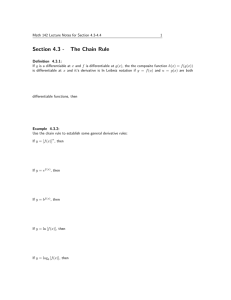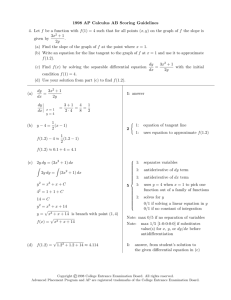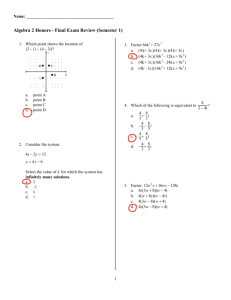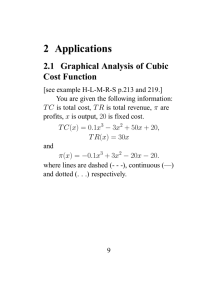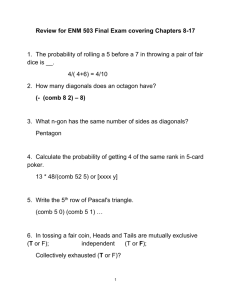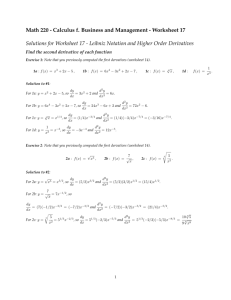File
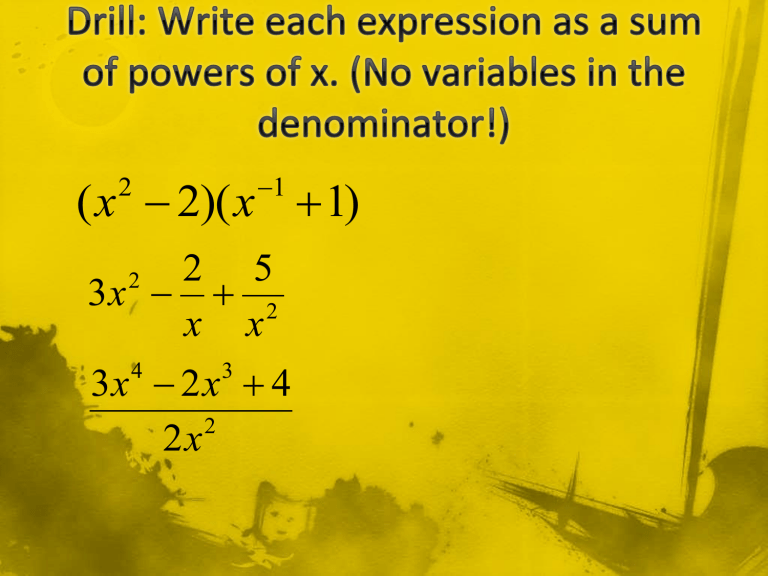
( x
2
2 )( x
1
1 )
3 x
2
2 x
5 x
2
3 x
4
2 x
3
4
2 x
2
Day #1 Homework page 124: 1-13, 15-22 (do not show graphically)
If is the function with the constant value c, then df/dx = d/dx (c) = 0
Example: y = 4, find dy/dx
dy/dx= 0
If n is a positive integer, then d/dx (x n ) = nx n-1
Examples:
y = x 3
dy/dx= 3x 2
y = 4x 4
dy/dx = 16x 3
If u and v are differentiable functions of x, then their sum and differences are differentiable at every point where u and v are differentiable:
d/dx ( u ± v) = du/dx ± dv/dx
Example:
y = x 3 + ½ x 2 – 3x + 2
dy/dx= 3x 2 + x - 3
Does the curve y = x 4 – 2x 2 + 2 have any horizontal tangents? If so, where?
Calculate dy/dx
4x 3 – 4x
Solve the equation dy/dx = 0 for x.
4x 3 – 4x = 0
4x (x 2 – 1) = 0
4x (x – 1) (x + 1) = 0
4x = 0; (x – 1) = 0; (x + 1) = 0
x = 0, 1, -1
d/dx (uv) = u (dv/dx) + v(du/dx)
Find f’(x) if f(x) = (x 2 + 1) (x 3 + 3)
Let u = x 2 + 1 and v = x 3 + 3
dv/dx = 3x 2 and du/dx = 2x
u (dv/dx) + v(du/dx) = (x 2 + 1 )(3x 2 ) + (x 3 + 3)(2x)
3x 4 + 3x 2 + 2x 4 + 6x
5x 4 + 3x 2 + 6x
d dx u v
v du dx
v
2 u dv dx u
x
2
1 du / dx
2 x v
x
2
1 dv / dx
2 x v
2
( x
2
1 )
2 f ( x )
x
2 x
2
1
1 d dx u v
( x
2
1 ) 2 x
( x
2 x
3
2 x
( x
2
2 x
3
1 )
2
2 x
( x
4 x
2
1 )
2
2
( x
2
1 )
2
1 ) 2 x
2x
6
– 5x
4
+ 2x
(x 3 + x) (2x 2 + 3) x x
2
3
1
1
Let y
1
= f’(x) and y coincide.
2
= NDER f(x). They should
Let y = uv be the product of the functions u and v. Find y’(2) if
u(2) = 3, u’(2) = -4, v(2) = 1 and v’(2) = 2
So, from the product rule:
u(2)v’(2) + v(2)u’(2)
3(2) + 1(-4) = 2
If n is a negative integer and x ≠ 0, then
d/dx (x n ) = nx n-1
Example: f(x) = -2x -3
f’(x) = 6x -4
Find an equation for the line tangent to the curve y = (x 2 + 3)/2x at the point (1, 2)
While we could find the derivative by the Quotient
Rule, but it is easier to first simplify into a sum of two powers: (x 2 /2x) + 3/2x = ( ½ ) x + (3/2)x -1
dy/dx = ½ - (3/2)x -2
The slope at x = 1:
½ - (3/2) (1) -2 = ½ - 3/2 = -1
Using the slope of -1 and the point (1, 2):
y – 2 = -1 (x – 1 ) y = -1x + 3
dy/dx: first derivative
f’(x) = y’
dy’/dx = second derivative
f’’(x) = y’’ = d 2 y/dx 2
dy’’/dx = third derivative
f’’’(x) = y’’’ = d 3 y/dx 3
etc….
y’: 3x 2 – 10x
y’’ = 6x – 10
y’’’ = 6
y’’’’= 0
(page 123, example 5)
An orange farmer currently has 200 trees yielding an average of 15 bushels of oranges per tree. She is expanding her farm at the rate of 15 trees per year, while improved husbandry is improving her average annual yield by 1.2 bushels by tree. What is the current (instantaneous) rate of increase of her total annual production of oranges?
Let t(x) = the number of trees x years from now
Let y(x) = yield per tree x years from now
p(x) = t(x)y(x) is the total production of oranges in year x.
We know t(0) = 200; y (0) = 15; t’(0) = 15; y’(0) = 1.2
We need to find p’(x), so we can use the product rule:
t(0)y’(0) + y(0)t’(0)
200(1.2) + 15(15) = 465 bushels per year.
page 124-125:23-37, 51
